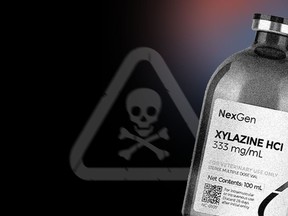
Article content
A toxic drug is making its way to the local drug supply – and it’s one without a known antidote, the local health unit said Tuesday.
Advertisement 2
Article content
The Leeds, Grenville and Lanark District Health Unit warned this week about the animal tranquilizer Xylazine being found cut into illegal drugs being seized throughout the country.
Xylazine, also known by the term Tranq, is “a sedative drug that is used in veterinary medicine and is currently not approved for human consumption.”
It is being added to fentanyl, further poisoning an already toxic unregulated drug supply, the health unit said. Xylazine is not an opiate, so it is resistant to naloxone, the medication used to reverse opioid drug poisoning.
Dr. Linna Li, the health unit’s medical officer of health, said the use of xylazine in the Ontario unregulated market is “still new enough that the level of concern is still not completely clear,” but they have received reports that it has been found in Eastern Ontario.
Article content
Advertisement 3
Article content
“We know this substance has been found in the unregulated drug supply across the province and it has been confirmed in at least one instance in a neighbouring region,” Li said on Tuesday.
“My concern stems from the fact that there are no known antidotes for xylazine, and naloxone, which is effective for opioids, will not reverse the effect of this substance.”
Xylazine is dangerous in many ways, Li said, since it “is not approved for human use.”
“Its effects on (human) health are not well understood,” she said.
“We do know that it can cause people to stop breathing, slow their heart rate, and lose consciousness and it can also cause skin ulcers and rashes. We also know it can be addictive.”
When the tranquilizer is used in conjunction with other substances – such as opioids or benzodiazepines that cause sedation and central nervous system depression – the risk of experiencing a fatal drug poisoning “significantly increases,” officials added.
Advertisement 4
Article content
It has made its way to the local drug supply, and it is “appearing in an alarming percentage” of the fentanyl seized by law enforcement in Canada, they said.
According to a recent Government of Canada Drug Analysis Service report, the majority of xylazine identifications are coming from Ontario with 62.7 per cent of all cases, with British Columbia in a distant second at 21.2 per cent and Alberta at 12.9 per cent.
The animal tranquilizer is commonly found in substances containing two or more other substances, such as caffeine and fentanyl, they said.
In an effort to prevent overdoses and deaths, local officials say naloxone training and administration is imperative but they’re highlighting the importance of calling 911 for medical assistance in all suspected drug poisoning.
Advertisement 5
Article content
“Naloxone remains highly effective in reversing the opioid overdose even when other substances are involved,” the health unit urged.
“All drug poisoning are considered a medical emergency and seeking out emergency medical care is a vital step in the prevention of further fatalities.”
The risk of an overdose can be reduced, they said, by following safer use practices, including calling 911 in the event of an overdose, carrying a naloxone kit, avoiding mixing substances, using a small test dose first, and not using alone.
If a person has no other choice but to use alone, they’re encouraged to call the Overdose Prevention Hotline 1-888-688-6677.
Health Unit warns about toxic drug supply - The Recorder and Times
Read More


Comments
Postmedia is committed to maintaining a lively but civil forum for discussion and encourage all readers to share their views on our articles. Comments may take up to an hour for moderation before appearing on the site. We ask you to keep your comments relevant and respectful. We have enabled email notifications—you will now receive an email if you receive a reply to your comment, there is an update to a comment thread you follow or if a user you follow comments. Visit our Community Guidelines for more information and details on how to adjust your email settings.
Join the Conversation